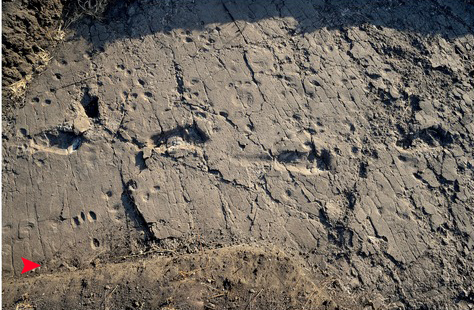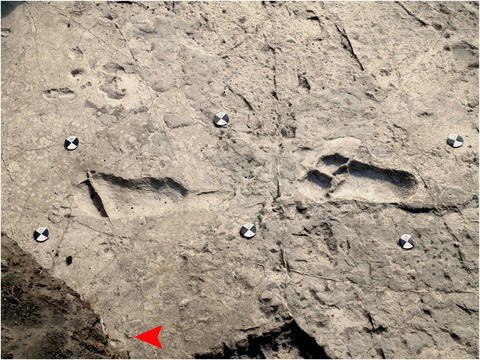Marked Variation in the Body Size of Australopithecus afarensis
Fossil Footprints from Tanzania Shed Light on Marked Body Size Variation in A. afarensis
Newly discovered footprints of early hominins found by researchers from the University of Dar es Salaam in collaboration with Italian colleagues, show marked body size variation in our 3.66-million-year-old ancestors.
Studying Hominin Footprints
Analysis of the footprints hints at a social grouping structure more akin to modern gorillas than to chimpanzees and bonobos. The impressions were created when a group of ancient bipeds walked across wet volcanic ash, these new prints, showing evidence of two individuals walking together were found within 150 metres of the hominin trace fossils discovered in 1978. The 1978 fossils were attributed to the species of hominin (a primate more closely related to our species than to a chimpanzee), dubbed Australopithecus afarensis. These newly described tracks too, have been attributed to this species. They show two individuals, named S1 and S2 in the study, moving on the same palaeosurface and in the same direction as the three hominins documented in the 1978 discovery.
A Notable Size Difference
In the scientific paper published in the journal “eLife”, the researchers report that the specimen referred to as S1 had much larger feet than any other member of this group. Size estimates for this individual indicate an Australopithecus standing 1.65 metres tall (five feet, five inches tall), not as tall as a modern man (H. sapiens), but around five centimetres taller than the height of the average British woman.
Ancient Footprints May Indicate Marked Body Size Difference in Australopithecus afarensis
Picture credit: Raffaella Pellizzon with additional annotation by Everything Dinosaur
In the photograph above, the footprints can be clearly made out, along with tracks made by a number of other Pliocene animals. The red arrow in the bottom left hand corner marks the direction of travel of the hominins.
The research team propose that these new tracks when reviewed in conjunction with the 1978 trace fossil discovery, may provide clues as to how this ancient species of early human lived. The newly discovered prints, including the large prints of S1, might be the tracks of a male walking with a collection of smaller females and their offspring.
An Australopithecus Harem?
Commenting on the implications for social behaviour, lead researcher Professor Giorgio Manzi (University of Roma, Italy) stated:
“This novel evidence, taken as a whole with the previous findings, portrays several early hominins moving as a group through the landscape following a volcanic eruption and subsequent rainfall, but there is more. The footprints of one of the new individuals are astonishingly larger than anyone else’s in the group, suggesting that he was a large male member of the species.”
A Closer View of the Hominin Tracks
Picture credit: Raffaella Pellizzon with additional annotation by Everything Dinosaur
The Largest Austalopithecus Described to Date
Standing around 1.65 metres tall, makes S1 the largest Australopithecus individual described to date.
Commenting on the significance of this new trackway and its proximity to the other Australopithecus tracks, co-author Jacopo Moggi-Cecchi (University of Florence) said:
“Now that we’ve found a new set of footprints it opens up a completely different window and there could be a number of new possibilities to study what is a photograph in time of the everyday life of this species.”
The finding of a male perhaps walking with several females could mean their social structure was closer to the gorilla-like model than to chimpanzees or to modern humans. These tracks could be interpreted as a large, dominant male walking with his troop of female mates, a sort of Australopithecus harem.
A Map Showing the Location of the Trackways in Northern Tanzania
Picture credit: eLife
Reassessing the Pliocene Record of Early Hominins
This new trackway evidence, in combination with a comparative reappraisal of the 1978 footprints has important implications for the Pliocene record of early hominin behaviour and morphology. The results are consistent with considerable body size variation and, probably a degree of dimorphism between males and females within a single species of bipedal hominin as early as 3.66 million years ago.
A Line Drawing of the Hominin Tracks and Other Associated Features
Picture credit: eLife
The four excavated pits that make up the new trackway evidence are represented above in the line drawing.
Dashed lines indicate uncertain contours. Some of the most interesting tracks are coloured: hominins in orange (heel drags in dark grey), prehistoric horses in dark green (M9), rhinoceros in red (M9), giraffe in light brown (M10), and guinea fowl in blue (M10). Large roots and the bases of trees are in light green (L8). The main faults/fractures are indicated by brown lines. Raindrop impressions occur in the northern part of L8 (dotted areas).
The scientific paper: “New Footprints from Laetoli (Tanzania) Provide Evidence for Marked Body Size Variation in Early Hominins” published in the journal eLife.
Visit the website of Everything Dinosaur: Everything Dinosaur.





